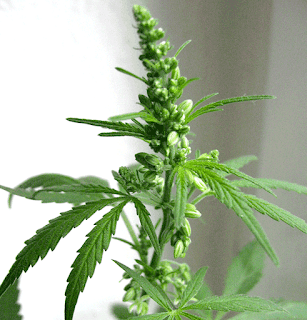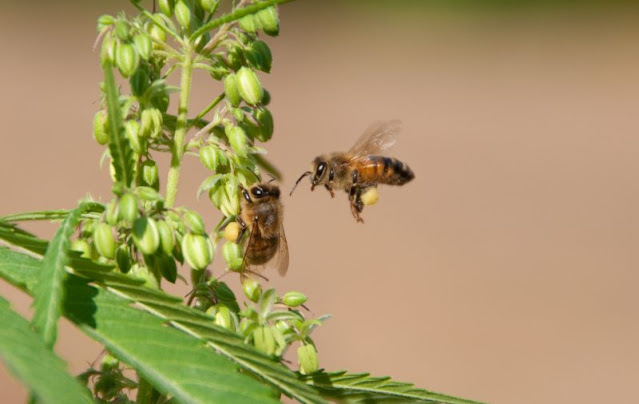In my book Cannabis
is The Human Companion plant I discuss the uses and potency of the male
Cannabis plant.
There are not many people who have or would grow the
male plant to maturity so research is hard to come by. In 1998 I was arrested
for cultivation of 98 male Cannabis plants in Port Elizabeth. Each and every
male Cannabis plant was ripped out of its soil and tossed in the police-van. It
was a big landscaping project for SAPS at that time and in their excitement
they actually left the only 2 female plants behind in the garden!
For decades now I have been fascinated by the botanical and
medical abilities of the male Cannabis plant. Many people believe that the male
Cannabis plant does not produce THC or CBD. This is a myth and the truth is
that male Cannabis plants contain more THC in their flowers than in the leaves
of female plants. However, just like female flowers, the strain of the plant is
equally important for male Cannabis plants.
Here’s a story about “Harvey” the 80 kg male Great Dane
who knows all about the potency of the male Cannabis plant. Harvey is my son’s
beloved dog and therefore my grandson.
After extracting 100 grams of the male Cannabis “White
Rhino” strain into 1.2 liters of organic virgin coconut oil, I very carefully
disposed of the left-over plant material. Unfortunately Harvey could not
control himself and sought out and consumed about half the remaining biomass.
He was literally down for 3 days and I stayed with him
the whole time. In this time he could neither stand up off the couch he lay on,
nor could he drink water by himself. Despite my anxiety I knew that he would
not die. And he was certainly not crying or showing any signs that he might
need to go the vet. This was the ‘highest’
I have ever seen a dog or any other animal, including cows and goats. After the
third day he rose off the couch and carried on as if nothing had happened, but
I swear he did wink at me once or twice!
The female White-Rhino Cannabis plant tests on average
between 18 to 20% THC and in the absence of analytics I would guess the male
plant to be at least 50% less at around 8 to 9% THC. If you consider that in
the 1960’s THC content of 6% was considered high then you can believe how one
80 kg dog had to lay down for 3 days due to consuming a male Cannabis plant.
What’s the buzz with male Cannabis plants?
In my heart I have always believed that the future of my
medicine is to produce Cannabis honey that comes straight out the bum of the
bees. I believe that everything that passes through the body of a bee is
basically perfect! And I would do this by working with the male Cannabis plant
that produces a unique type of pollen.
As a Cannabis lecturer I’m bound by textbooks that state
what all scientists are saying; that insects don’t have cannabinoid receptors. However,
I do prefer to give my students the full story. It was around 2015 when I
received groundbreaking research from Hebrew University. The veterinarian’s
findings established that the only creature on earth without cannabinoid
receptors was in fact the bee. And I have always believed this and wondered why
science would not report this fact instead of claiming that the entire insect
kingdom doesn’t enjoy endocannabinoid system? This also leads to other
questions about bees like where do they come from?
My research reveals that other insects either have these
receptors e.g. fruit flies. Or they express Arachidonic acid which is the
biological precursor to endocannabinoids in humans and animals. So far I have
looked at scientific reports concerning crickets, locusts, fruit flies,
mosquitoes, fire-flies, house-flies, ants (I have set traps to prove that they do
eat ganja seeds!) and of course honeybees.
There are some interesting Cannabis research programs
using fruit flies in the study of epilepsy. Did you know that fruit flies can
have seizures? Not only that but they also share around 85% of human
disease-causing genes. This is why they are so valuable in medical research.
There are even entomology studies going back to 1979
about insects having endocannabinoid systems. And recent studies confirm that
Arachidonic acid ensures the synthesis of 2-AG and Anandamide in flies. So just
like the human endocannabinoid system this is not new information.
Scientists have observed that honey-bees that were fed
Arachidonic acid displayed improved growth, survival, health, appetite and
immune functions. It is very interesting that supplementation of Arachidonic
acid is proving to be important for the overall health of honeybees even though
they can’t manufacture this substance themselves.
If you consider how long it took scientists to identify
the human ECS then I feel that it might take much longer to locate the tiny
little receptors in the brains of insect genomes. It is also extraordinary that
even the jelly fish that does not have a brain, in fact has endocannabinoid
receptors within. Of course more meaningful research is required in this field
of study.
Bees are naturally attracted to the male Cannabis plant because of the pollen and this is my idea of pure organic Cannabis honey. The Frenchman, Nicolas Trainer-Bees uses sugar-water to entice bees to female flowers where they work with the resin. After years of watching his work I am convinced that there is absolutely no stress on the bees and they produce a beautiful avocado-green honey that I would love to get my hands on. I recognize that particular shade of green in plant medicine. You can tell that it is real because neither honey nor organic virgin coconut oil will strip the plant chlorophyll, only the fat soluble components of the plant. In comparison, you can see that smoothies for example are much darker in color because it contains more plant cholorophyll. But still I am adamant that my medicinal honey will be sourced from the pollen of the male Cannabis plant.
There are many pictures circulating the internet like
this one below that shows bees buzzing around female plants. Many believe that
sugar-water is used to entice bees to the females and to make the females
appear more potent in pictures.
Be that as it may, I have it on good authority from
trusted bee-keepers who are also Cannabis growers. They all confirm that female
Cannabis plants don’t produce nectar because they are wind-pollinated and also
the plant produces buds and not blooms. Instead the female Cannabis plant
produces a resin.
Bees collect wax and resin from female Cannabis plants
and use these to create propolis to seal the hive and for the medicinal value
to the whole colony. This is another clue to the possibility of Endocannabinoid
activity within the order of bees.
And while I would never really recommend that anyone
smokes male Cannabis plant flowers they can be used for example in edibles,
various oils and even hash. There are so many uses for the male Cannabis plant.
Besides being good daddy’s they also make excellent juicing buddies.

We have learnt that the male Cannabis plant contains the
same cannabinoid-acids as the females do and in the same concentration. For
example THCA, CBDA, CBCA, CBGA and many more cannabinoid-acids are also present
in the male Cannabis plant. Various terpenes and terpenoids as well as
flavinoids have also been identified in the male Cannabis plant.
We also know that the acid-versions of cannabinoids have
the same healing properties as smoked cannabinoids. If this were not true then
how do we explain hundreds of thousands of health-conscious people benefiting
from raw-juicing without any ‘high’?
Why is Cannabis pollen unique?
In the 1970’s scientists already identified CBD and THC
in Cannabis sativa pollen as well as their acid versions of these cannabinoids.
Ten years ago they discovered a completely new cannabinoid now known as THCC
(Delta9-Tetrahydrocannaborcol). It is non-psychoactive and structurally almost
alike to THC. The only real difference is the number of carbon-atoms attached
to its functional side-chain. THC has 5 carbons and THCC only has 1. Originally
I believed this cannabinoid to be THC Delta-1 on the THC analogue list.
According to a 2005 PubMed study THCC is one of at least
12 cannabinoids found in Cannabis pollen with more being discovered on a
regular basis.
Some people believe that Cannabis pollen has no
medicinal value. But according to scientists THCC could have stronger pain-killer
properties than CBD.
It’s interesting to note that even though THCC is so
similar in structure to THC it does not actually bind with the endocannabinoid
receptors. This is why it is not psychoactive like Delta-9 THC. So like CBD,
this new cannabinoid now known as THCC is able to interact with the
pain-receptors known as the Vannilloid receptors. These receptors are the
gateway to the pathway of pain in humans and animals.
THCC is already being investigated in the treatment of
chronic nerve pain in people suffering with diabetes and fibromyalgia and other
neuropathic pain conditions. Studies are also being conducted in respect THCC’s
potential in the treatment of osteoarthritis pain and the pain caused by many
chemotherapy treatments.
Migraine pains are also being studied. From personal
experience I can confirm that male cannabinoids that I extract with organic
virgin coconut oil has high efficacy as a topical treatment for migraine
headaches for many of my patients. There is not much scientific literature at
this time, but we do know that THCC is unique to male Cannabis plants. The
future of the male Cannabis plant is secured because of his own exclusive
healing properties.
REFERENCES:
1. Cannabis
is The Human Companion plant by Sista Vee Nohombile
2. Xhosa
Styles!: WHAT ABOUT THE MALE CANNABIS PLANT?
3. The
Constituents of Cannabis sativa Pollen (M. Paris, F. Boucher, L. Cosson) Economic
Botany, Vol. 29, No. 3 (Jul. - Sep., 1975), pp. 245-253 http://www.jstor.org/stable/4253616







Beutifull , Thank you Sister Vee 💚
ReplyDelete